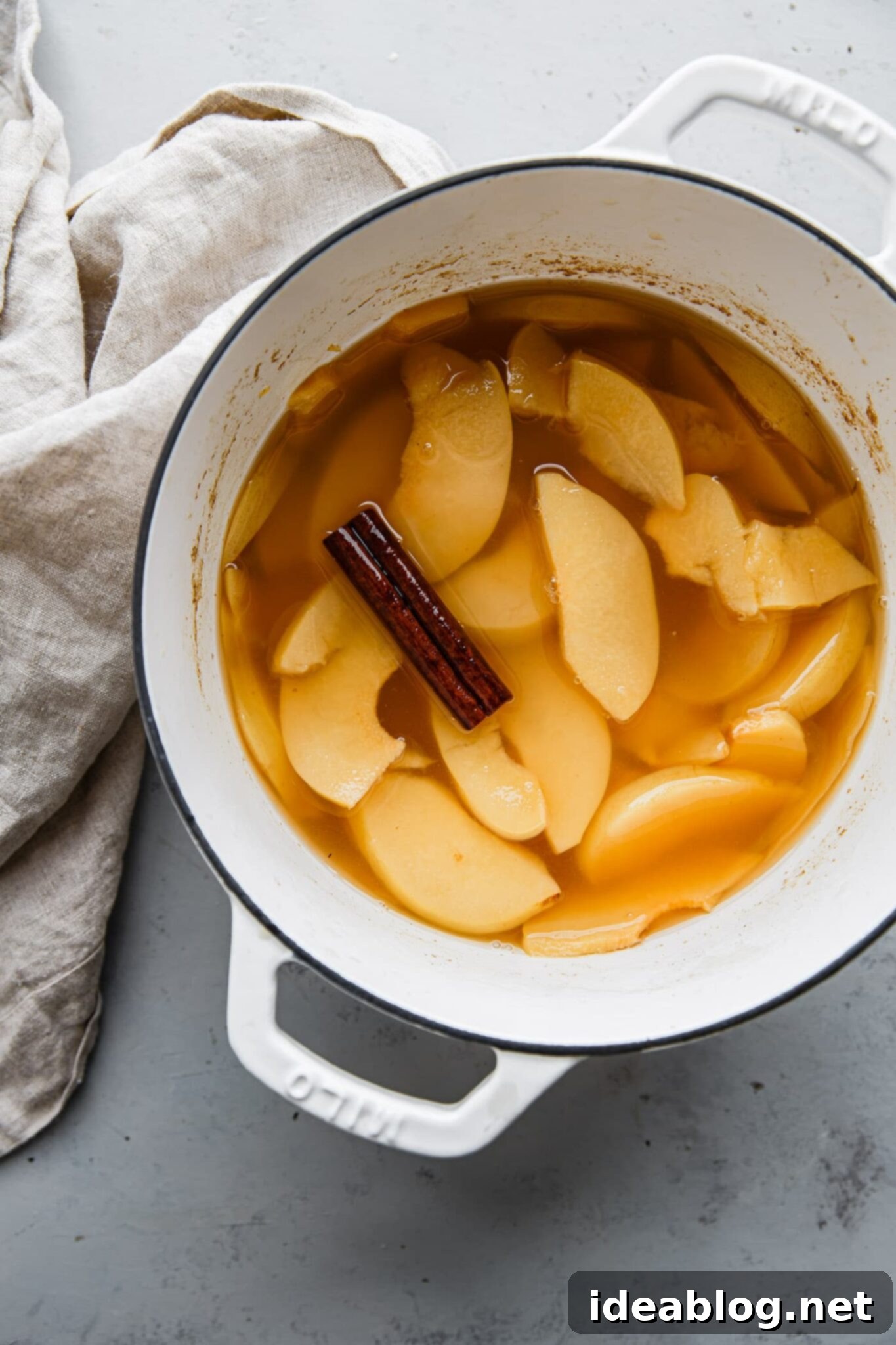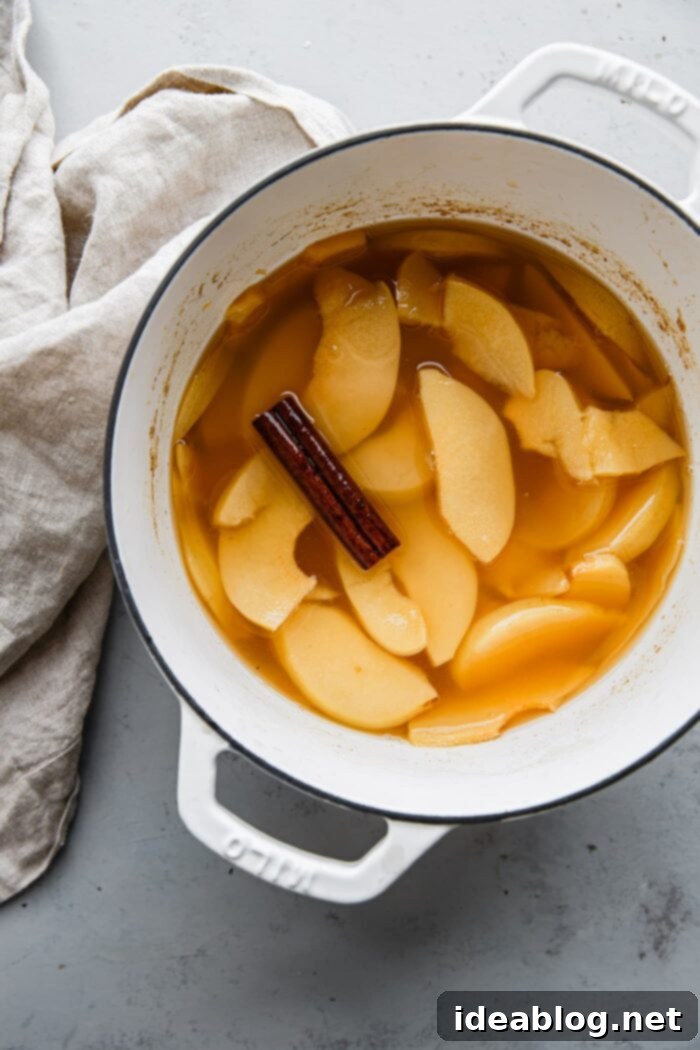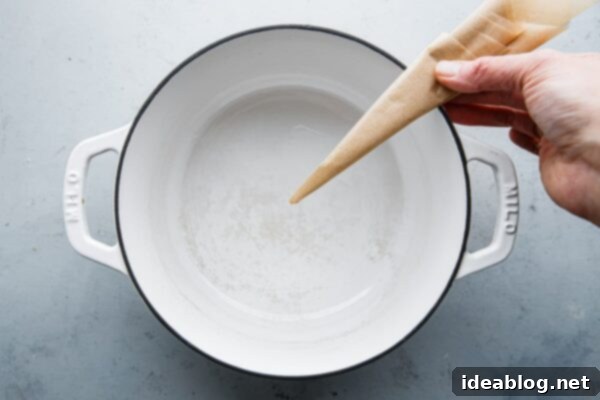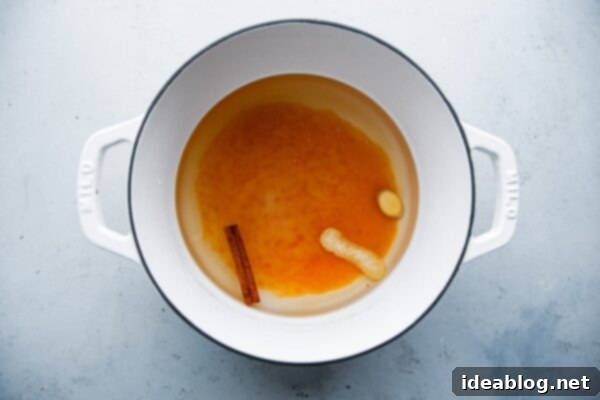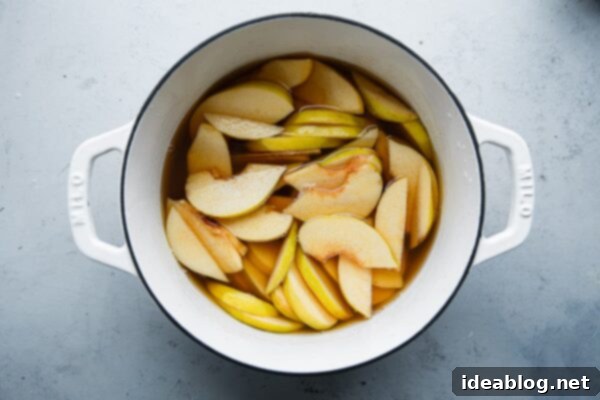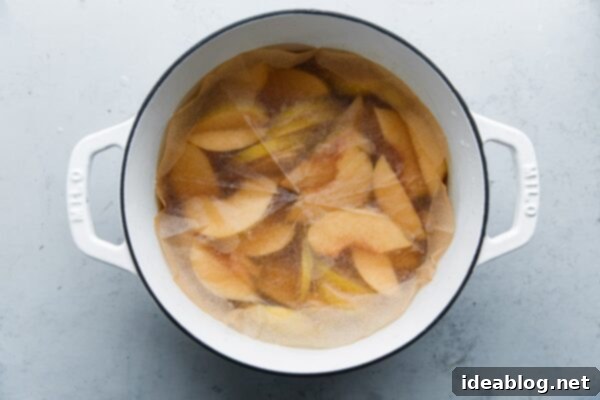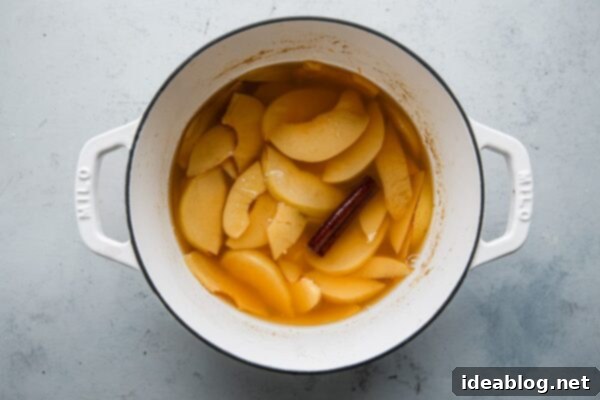Perfectly Poached Quince: A Fragrant and Flavorful Fall Dessert Guide
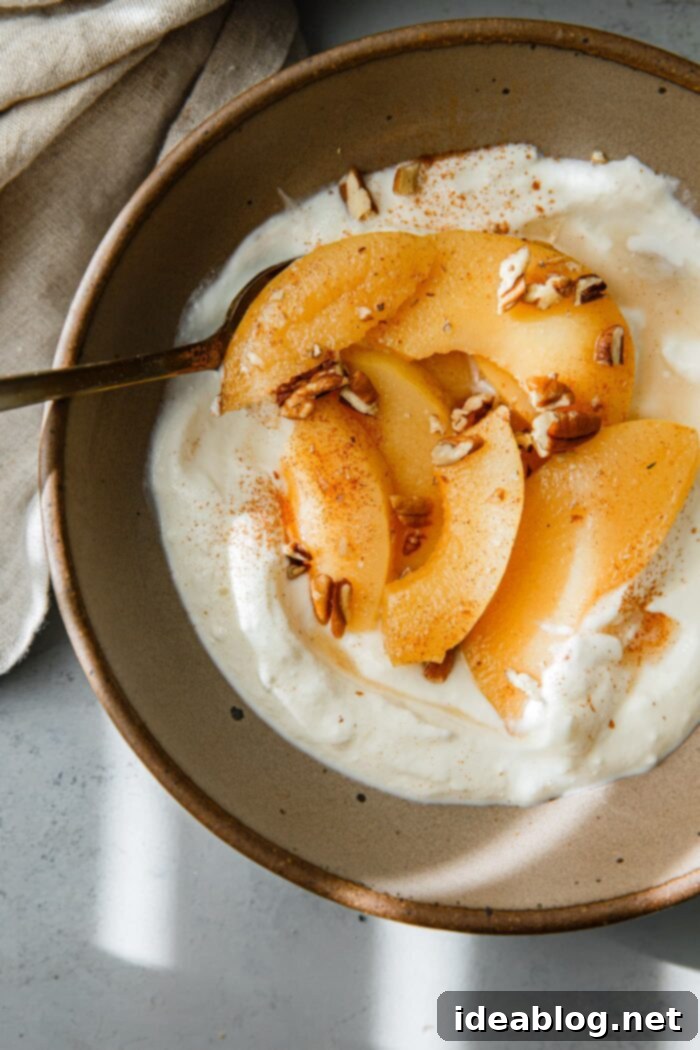
Poached fruit represents one of autumn’s most delightful yet often overlooked culinary treasures. While many gravitate towards apple and pumpkin, there’s a unique seasonal gem that deserves a spotlight: quince. Today, we’re stepping away from the traditional fall dessert repertoire to explore this exquisite fruit with our simple, incredibly flavorful Poached Quince recipe. This guide will help you master the art of poaching this aromatic fruit, turning it into a truly memorable seasonal indulgence.
Quince, when raw, is notoriously tough and tart, but its true magic unfolds when gently cooked. Poaching transforms this unassuming fruit into a tender, fragrant delicacy, infused with warm spices and a captivating floral aroma unlike any other. The result is a delicious treat that can be enjoyed in a multitude of ways—on its own as a light dessert, paired with creamy yogurt or a scoop of vanilla ice cream, or drizzled over fluffy pancakes or waffles for an elevated breakfast experience. This recipe is designed to bring out the very best in quince, highlighting its unique texture and exquisite flavor profile.
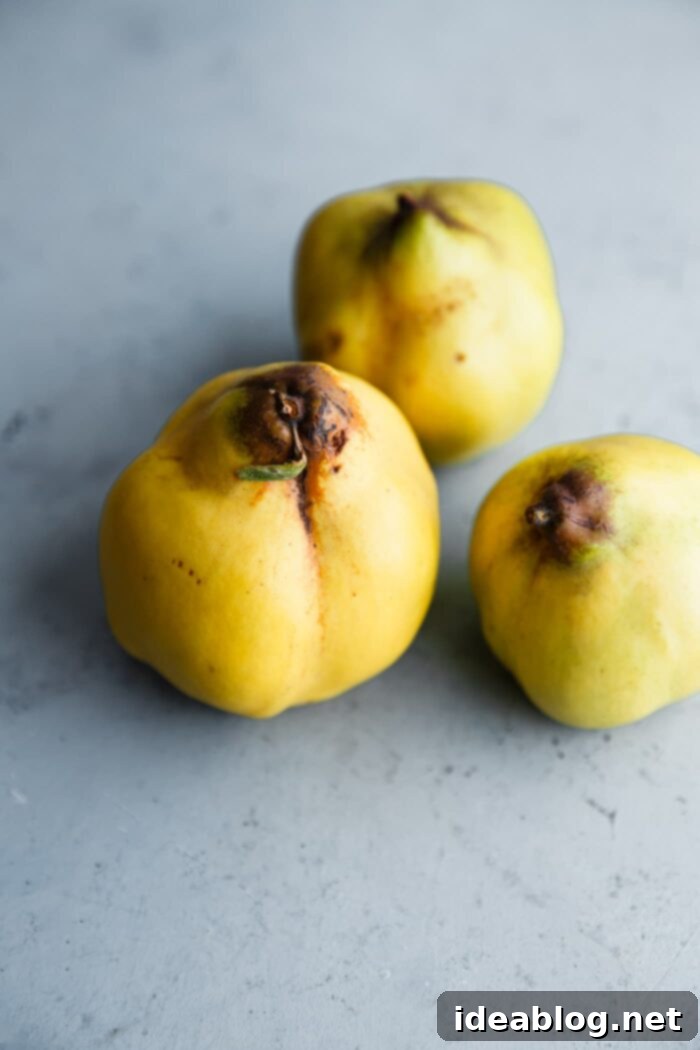
What Exactly Are Quince? Understanding This Unique Fruit
Quince (scientifically known as Cydonia oblonga) is an ancient fruit with a rich history, believed to originate from the Caucasus region. It’s often described as a cross between an apple and a pear due to its appearance and some textural similarities, yet it possesses a highly distinctive, intense floral and citrusy aroma that truly sets it apart. While its shape can vary, from apple-like to pear-shaped, its vibrant yellow skin upon ripening is a key indicator of its readiness for harvest.
Unlike apples or pears, quince is typically not eaten raw due to its incredibly tough, astringent, and gritty flesh. Its high pectin content and unique tannins require cooking to break down, soften, and sweeten the fruit, transforming its pale, almost white flesh into a beautiful rosy pink or deep amber color, depending on the variety and length of cooking time. This remarkable transformation is a major part of its culinary charm and why poaching is such a popular method for preparing it. When raw, preparing quince requires considerable effort; you’ll need a large, very sharp knife and a steady hand, as it can be quite dense and firm. Be mindful that quince oxidizes quickly once sliced, similar to apples, so it’s best to prepare it just before you’re ready to cook.
Many traditional recipes suggest peeling quince, but for this gentle poaching method, we advocate for leaving the skin on. The tough outer layer softens considerably during cooking, becoming perfectly edible and contributing to the fruit’s beautiful color and textural integrity. If you’re particularly sensitive to texture or prefer a smoother result, a vegetable peeler can be used, but we highly encourage you to try it unpeeled first! Beyond its undeniable culinary appeal, quince is also a good source of dietary fiber, Vitamin C, and various antioxidants, making it not just a delicious treat, but a wholesome one too. Its unique properties and health benefits make it a fantastic addition to your autumn diet.
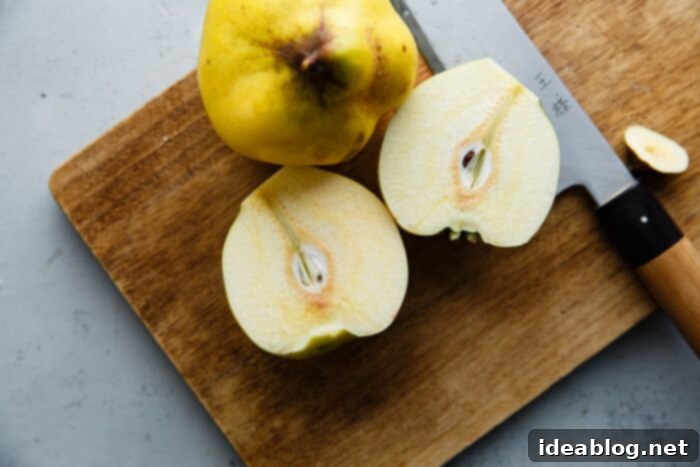
Quince Shopping Tips: How to Select the Best Fruit
Finding fresh quince can sometimes feel like a treasure hunt, but the effort is well worth it! Quince season typically runs from September through December, making it a quintessential fall and early winter fruit. You’ll most likely discover them at specialty supermarkets, international grocery stores, or directly from local vendors at farmer’s markets during their peak season. Don’t be shy to ask your local grocer if they can order them for you if you’re having trouble locating them.
When selecting quince, look for fruits that are large, firm, and predominantly yellow in color, with minimal green patches. This vibrant yellow hue indicates that the fruit is ripe and ready for cooking. Avoid any quince with soft spots, bruises, or signs of mold, as these can indicate spoilage. The fruit should feel notably heavy for its size and, perhaps most importantly, emit a strong, pleasant, flowery fragrance. This distinctive aroma is a key indicator of good quality, ripe quince and promises a flavorful poaching experience. Once purchased, you can store quince at room temperature for a few days if you plan to use it soon. For longer storage, wrap the fruit loosely in plastic or paper towels and keep it in the refrigerator’s crisper drawer, where it can last for up to two months, preserving its unique fragrance and freshness.
Essential Ingredients You’ll Need:
Crafting perfectly poached quince involves a thoughtful combination of the fruit itself, carefully selected sweeteners, and aromatic spices that beautifully complement its unique flavor profile. Each component plays a vital role in creating this comforting fall dessert.
- Quince: As the star of our dish, selecting ripe, firm quince is crucial for the best results. Remember to refer to our shopping tips above to pick the perfect fruit. If fresh quince proves elusive in your area, don’t despair! This versatile poaching technique and its flavorful liquid can be successfully adapted for other firm fruits like apples or pears, offering a similar comforting fall experience.
- Honey and Granulated Sugar: Our poaching liquid achieves a perfect balance of sweetness and depth using both liquid honey and granulated sugar. Following a common ratio of approximately 4:1 (liquid to sugar), this blend ensures the fruit is sweet without being cloying, while the honey imparts a lovely, complex floral note. This is a similar principle we apply in recipes like our Pear Frangipane Tart, where a subtle sweetness enhances the fruit. For a different flavor dimension or if you prefer, you could also substitute maple syrup for part or all of the honey.
- Aromatics and Spices: These ingredients are key to infusing the quince with its signature warm and inviting flavor, transforming it into a truly aromatic delight.
- Cinnamon Stick: Adds a classic, comforting autumnal warmth that pairs beautifully with fall fruits.
- Whole Cloves: Their pungent, sweet, and slightly bitter notes wonderfully complement the quince, adding a layer of sophisticated flavor.
- Fresh Lemon Peel: Provides a bright, zesty counterpoint, cutting through the sweetness and enhancing the fruit’s natural acidity. Be sure to use a vegetable peeler to get just the colorful zest, minimizing any bitter white pith.
- Fresh Ginger: Offers a subtle, spicy kick and an invigorating aroma. A thin, unpeeled round slice is all you need for a gentle, warming infusion.
- Pure Vanilla Extract or Vanilla Bean Paste: Delivers a rich, creamy, and universally beloved aroma that ties all the other spices together, adding a luxurious finish.
- Pinch of Kosher Salt: A small amount of salt enhances all the other flavors, making the sweetness and spices truly sing and preventing the dessert from tasting flat.
- Cold Water: The base of our poaching liquid, it allows the flavors to meld gently and provides the essential medium for the quince to slowly soften and absorb all the beautiful aromas and sweetness.
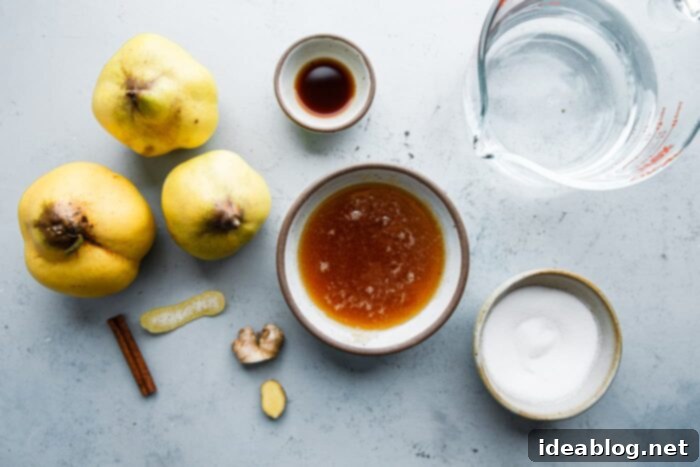
How to Poach Quince: A Step-by-Step Overview
Poaching quince is a surprisingly straightforward process that yields incredibly rewarding results. Here’s a simplified overview of the steps involved to give you a clear understanding of the process; for precise measurements and highly detailed instructions, please refer to the comprehensive recipe card below.
- Prepare the Poaching Liquid: In a large saucepan, you’ll combine cold water with honey, granulated sugar, and all your chosen aromatics and spices. Gently bring this flavorful mixture to a simmer over medium heat, stirring just until the sugars have fully dissolved. This creates a beautifully fragrant base that will infuse the quince with exquisite flavor.
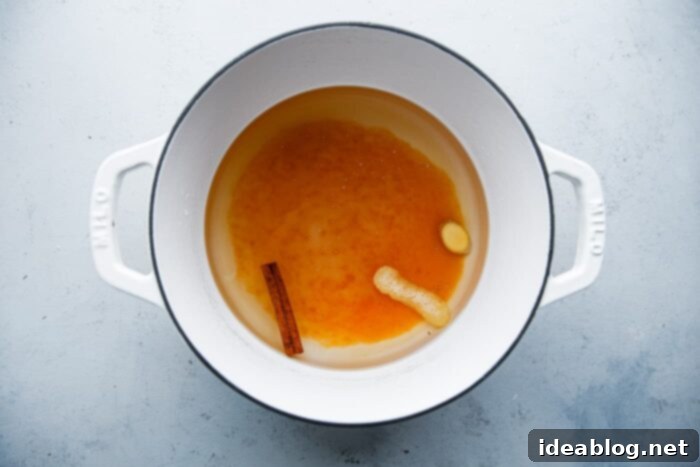
- Prepare and Chop Quince: With a sturdy, sharp knife and a steady hand, carefully slice the raw quince in half lengthwise. The core can then be efficiently removed using a melon baller or by quartering the fruit and slicing it out with a paring knife. Next, slice the quince halves into uniform, approximately ¼-inch thick pieces. Immediately transfer these slices into the warm poaching liquid, ensuring they are mostly submerged to prevent rapid oxidation and ensure even cooking and color development.
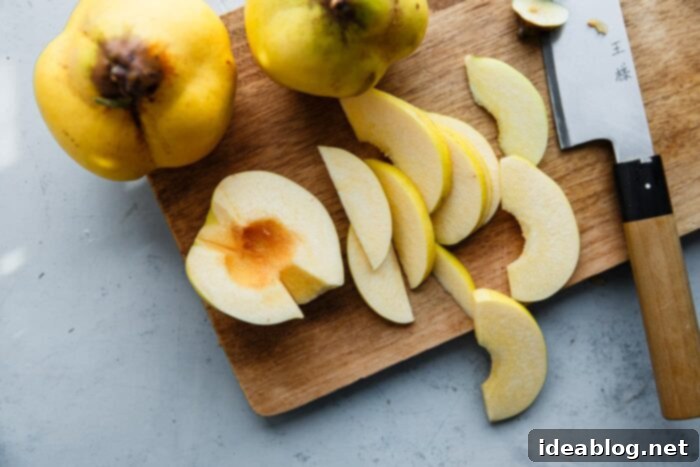
- Gentle Simmering: Return the saucepan to a very low simmer. To ensure the quince cooks evenly and stays perfectly submerged in the aromatic liquid, cover the surface of the fruit with a parchment paper “cartouche” (detailed instructions for making this are provided within the full recipe card). Allow the quince to gently simmer, flipping the slices once or twice during the process, for approximately 15 to 25 minutes, or until the fruit is beautifully fork-tender and has taken on a lovely rosy hue. Cooking times can vary based on the ripeness and size of your quince, so it’s always wise to begin checking for doneness after about 10-15 minutes and adjust the time as needed.
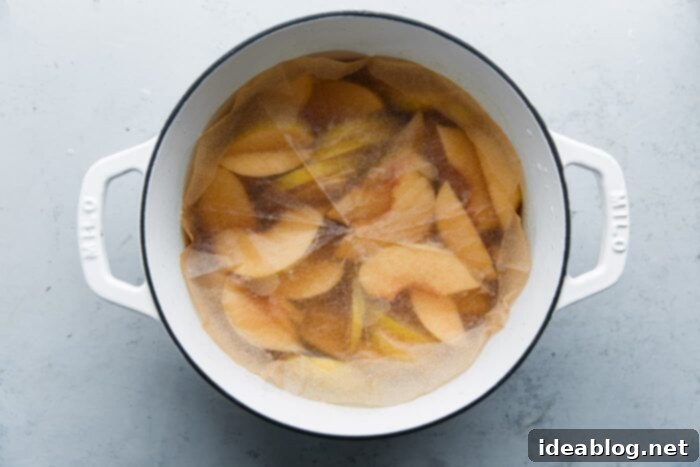
- Cooling and Storage: Once tender, remove the saucepan from the heat and allow the poached quince to cool completely to room temperature *within* its flavorful poaching liquid. This crucial step not only allows the fruit to absorb even more of the infused flavors but also helps it develop its beautiful, characteristic rosy pink or amber color. For serving, you’ll want to carefully remove the whole spices (cinnamon stick, cloves, ginger, and lemon peel). Store the quince slices, submerged in the poaching liquid, in an airtight container in the refrigerator for up to one week, ensuring maximum flavor and freshness.
How to Serve Perfectly Poached Quince
The versatility of perfectly poached quince makes it a wonderful and sophisticated addition to various meals, from a wholesome breakfast to an elegant dessert. Its unique flavor profile complements a wide range of dishes:
- On its own: Enjoy poached quince simply as a light, fragrant, and satisfying dessert. The subtle sweetness and complex spice notes are truly delightful and require no embellishment.
- With Yogurt: Layer tender poached quince slices with creamy Greek yogurt, a sprinkle of crunchy granola, and a generous drizzle of the poaching syrup for a nutritious, elegant breakfast or a healthy, indulgent snack.
- Over Ice Cream: Serve warm or chilled poached quince with a scoop of premium vanilla bean ice cream, a dollop of créme fraîche, or a spoonful of mascarpone cheese for a truly luxurious dessert. The contrasting temperatures and textures are simply sublime.
- Breakfast Topping: Elevate your morning routine by spooning poached quince over hot oatmeal, cream of wheat, fluffy pancakes, or crispy waffles. The rich, spiced syrup can beautifully replace traditional maple syrup for a delightful seasonal twist.
- In Baked Goods: Dice the cooled poached quince and gently fold it into your favorite muffin batter, tart fillings, or even a comforting crumble for added moisture, flavor, and a beautiful rosy hue.
- Savory Pairings: Don’t limit this exquisite fruit to just sweet dishes! Poached quince pairs surprisingly wonderfully with roasted pork or poultry, or as a sophisticated component on a gourmet cheese board, offering a sweet-tart counterpoint to savory elements.
Have Leftover Poaching Liquid? Don’t Throw It Out!
This aromatic, spiced syrup is far too precious and flavorful to discard! It’s a culinary gem that can be repurposed in several creative ways, extending the life of your poaching efforts and adding a touch of gourmet flair to other dishes.
- Poach More Fruit: The liquid is perfectly seasoned and ready to go for poaching additional batches of quince, or other complementary fruits like pears and apples, maximizing your seasonal harvest.
- Simple Syrup for Drinks: Transform it into a fragrant simple syrup to use in exquisite cocktails (imagine a spiced gin fizz or a unique Old Fashioned) or delightful mocktails. It can also be added to iced tea, lemonade, or sparkling water for a refreshing and aromatic twist.
- Reduce and Thicken: For a richer, more concentrated sauce or glaze, gently simmer the leftover liquid on the stovetop until it reduces and thickens to your desired consistency. This thicker syrup is fantastic for drizzling over desserts, pancakes, or even savory roasted meats.
- Storage: Store the leftover poaching liquid in an airtight container in the refrigerator for up to 10 days. For longer-term preservation, it freezes beautifully for several months; simply thaw it overnight in the fridge before you plan to use it again.
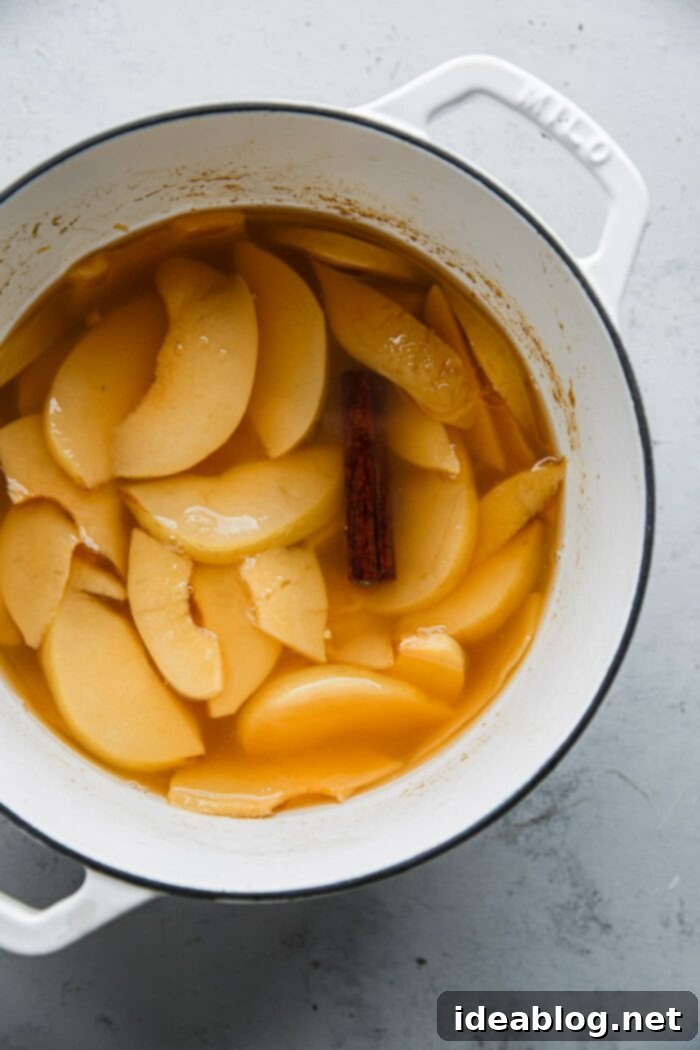
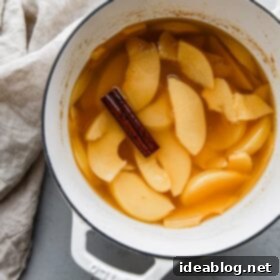
Simple Poached Quince
Pin
Review
SaveSaved!
Quince season is a short window, typically running from September to December. While sometimes challenging to locate, you’ll often find them at specialty supermarkets or bustling farmer’s markets during their peak. When selecting your quince, look for fruits that are large, mostly yellow (with only minimal green patches), and incredibly firm and hard to the touch, even when ripe. For short-term use, store them at room temperature; otherwise, wrap them loosely in plastic and refrigerate for up to two months to preserve their unique fragrance.
Equipment
-
4-5 Quart Saucepan
-
Natural Parchment Paper
Ingredients
Poaching Liquid:
- 3 cups (720 mL) cold water
- ½ cup (170g) liquid honey
- ¼ cup (50g) granulated sugar
- 4 whole cloves optional, but highly recommended for flavor
- 1 cinnamon stick
- 2 (2-inch long) strips fresh lemon peel use a peeler and minimize any bitter pith
- 1 (¼-inch thick) round slice fresh (unpeeled) ginger root
- 2 teaspoons pure vanilla extract or vanilla bean paste
- pinch kosher salt
Fruit:
- 2-3 quince (roughly 1½-1¾ lbs) see prep instructions below
Instructions
-
Make the Parchment Lid (Cartouche): Creating a parchment lid, or “cartouche,” is a simple yet effective technique to ensure your fruit cooks evenly and remains fully submerged in the flavorful liquid, preventing the top pieces from drying out. Begin by cutting or tearing a piece of parchment paper that is only slightly larger than the diameter of your chosen 4 to 5-quart saucepan. Fold this parchment circle in half, then fold it in half once more. This will give you a rough square of folded parchment. Now, take this square and fold it into a triangle, carefully aligning the folded edges. Repeat this folding process two more times, creating an even smaller, more pointed triangle.
Next, roughly align the tip of this tightly folded triangle with the ‘estimated’ center of your saucepan. Using a sharp pair of scissors, carefully trim the parchment, following the natural curve of the saucepan’s rim. When you unfold the parchment, it should form a perfect circle, designed to sit snugly inside the saucepan. Ideally, it should cover the entire surface of the poaching liquid and quince slices. A slight overhang is actually preferable for this application, as it helps create a more effective seal. Set this prepared parchment lid aside for now; you’ll use it during the poaching process.

-
Prepare Poaching Liquid: In your large saucepan, combine the specified amounts of cold water, liquid honey, granulated sugar, whole cloves (if you’re using them, as they complement quince beautifully), the fragrant cinnamon stick, fresh lemon peel (ensuring you minimize any bitter pith), the round slice of fresh unpeeled ginger root, pure vanilla extract (or vanilla bean paste for a more intense flavor), and a tiny pinch of kosher salt. Place this mixture over medium heat. Bring the liquid to a gentle simmer, stirring occasionally to help the sugars dissolve completely. Once simmering and the sugar is fully dissolved, you can remove the saucepan from the heat temporarily. This allows you time to prepare the parchment lid (cartouche) and, more importantly, to carefully slice your quince, which oxidizes quickly.

-
Note on Peeling: For this particular recipe, we will intentionally not peel the quince. The skin, though tough when raw, becomes wonderfully soft and perfectly edible once cooked, adding to the fruit’s integrity and beautiful color. This choice also conveniently eliminates an extra prepping step, which is especially helpful since quince flesh oxidizes very quickly upon exposure to air, much like an apple.
Chop Quince: With utmost care, slice each quince in half lengthwise. Be prepared: the flesh of a raw quince is incredibly dense and tough, so you will absolutely need a very steady hand and a large, sharp chef’s knife for this step. Once halved, use a sturdy melon baller to efficiently remove and discard the fibrous core. Alternatively, for those without a melon baller, you can cut the quince halves into quarters and then carefully slice away the core using a sharp paring knife. Next, place the quince pieces cut-side down on your cutting board and slice them into uniform ¼-inch thick pieces. Immediately transfer these freshly cut quince slices into the prepared, hot poaching liquid in your saucepan. It’s important that the slices are mostly submerged to ensure they cook evenly and begin absorbing the fragrant syrup.

-
Poach the Quince: Return the saucepan containing the quince and poaching liquid to your stovetop. Bring the liquid back to a very low, gentle simmer. Now, cover the entire surface of the quince and liquid with the parchment round (cartouche) you prepared earlier. This ensures that the quince cooks uniformly and stays submerged. Allow the quince to gently simmer, flipping the slices once or twice during the process to encourage even color and tenderness. The poaching time will range from approximately 15 to 25 minutes, or until the quince slices are beautifully fork-tender and have developed a lovely rosy hue. It’s crucial to note that total cook time can vary significantly based on the ripeness and variety of your quince, so I highly recommend checking for doneness after the first 10 to 15 minutes and then adjusting the remaining time as necessary. Keep in mind that the quince will continue to gently cook as it cools in the hot poaching liquid, so avoid overcooking it initially.

-
Cool and Store: Once the quince has reached the desired tenderness, remove the saucepan from the heat. Allow the poached quince to cool completely to room temperature *within* its aromatic poaching liquid. This crucial step is key for the fruit to fully absorb the rich flavors and develop its signature beautiful, translucent pink or amber color. Once cooled, the quince is ready to serve. For storage, carefully transfer the quince slices and their liquid into a large, airtight container. Storing the quince submerged in its poaching liquid ensures the best flavor and texture retention. It can be refrigerated for up to one week. Before serving, remember to remove and discard the whole spices (cinnamon stick, cloves), lemon peel, and ginger slices. As a bonus, the remaining poaching liquid is a treasure itself: it can be used to poach more batches of fruit or repurposed as a fragrant simple syrup in your favorite cocktails, mocktails, or even drizzled over other desserts.

Ways to Use Leftover Poaching Liquid:
- This flavorful, spiced syrup is too good to waste! Use it to poach additional batches of fruit like pears or apples, or transform it into a unique simple syrup for exquisite cocktails or refreshing mocktails. For a more concentrated and luxurious texture, gently reduce and thicken the liquid on the stovetop to create a rich glaze or sauce perfect for drizzling over desserts.
- Store this versatile liquid in an airtight container in the refrigerator for up to 10 days. For longer-term storage, it freezes beautifully; simply thaw it overnight in the fridge before you plan to use it again.
